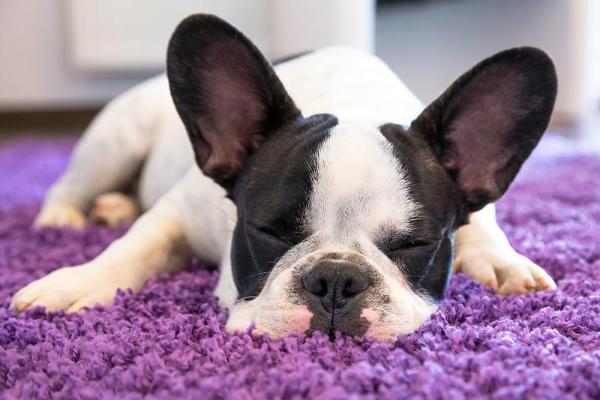
You’ve probably noticed that your dog loves to sleep in a specific position. But have you every wondered what the meaning of this dog sleeping position is? Firstly, it is important to remember that an adequate amount of good sleep is necessary for a dog’s well-being. Therefore, we suggest respecting your dog’s resting hours and try your best not to interrupt your dog when it is sleeping!
Do you want to know why your dog sleeps on its back or why your dog lays down on its side? To find out more about this dog behavior, take a look at this AnimalWised article! Here ¡we will be discussing dog sleeping positions and what they mean. In addition, did you know that a dog’s sleeping position can tell you a lot about their physical and mental health? keep reading for more.
1. Dog laying down - On its back, paws up
Dogs sleeping on their back with their paws facing upwards can be quite a funny dog sleeping position. But is this dog sleeping on its back position really comfortable? By exposing its most vulnerable parts, the dog unconsciously expresses well-being and lack of concern. This sleeping position can also become habitual in dogs that are nervous or excited. Does your dog sleep next to you on its back? Dogs laying on their back means that they feel very comfortable in their environment.

2. Dog sleeping position - Curled up
A dog normally sleeps curled up when they are cold. There is no doubt that seeing our dog curled up in this position, wrapping itself in its own tail, is terribly cute! This curled up sleeping position is incredibly common among puppies; looking to feel safer and more protected. We can compare this to the same feeling we as humans feel with snuggling, and the same can be said for dogs. This different dog sleeping position is comfortable and helps a dog maintain both heat and security.

3. Dog lying down - Face down on its stomach
Dogs sleeping face down is another dog position common among puppies. We will generally notice that puppies will sleep in this position after intense physical activity. This position is the most natural for puppy to take when it is exhausted and suddenly falls asleep.
However, this position is also very common in brachycephalic dogs (dogs with a short skull and snout). Brachycephalic dogs usually have trouble breathing. This face down sleeping position helps a dog breathe better. Some dogs also place themselves in this sleeping position when they are hot and want to cool down. Some examples of brachycephalic dog breeds, include;
- Pugs
- Bulldogs
- Chow chows
- Penkingese
To find out more about breathing difficulties in dogs, take a look at our article on:
- Dog Breathing Difficulties - Causes And Treatment

4. Dog sleeping position - On its side
Dogs sleeping on their sides is considered one the best positions a dog can adopt. This is because it allows them to be more comfortable and feel more relaxed. In addition, this sleeping position expresses that a dog feels secure, safe and comfortable enough to completely reveal its vital organs. In addition, this position allows them to reach their deepest sleep stages. When a dog sleeps in this position, movements or sleep twitching might appear more visible. For more, take a look at our article on; Why is My Dog Shaking While Sleeping?

5. Dog Lying down - Conventional dog sleeping posture
This dog sleeping position is somewhat of a combination between the ‘upside down’ and ‘curled up’ sleeping positions. This laying position is especially frequent in short rest periods. Dogs generally adopt this position when they are relaxed but also alert, for example; when they are at home alone or after eating.

6. Other dog sleeping positions
There are many other dog sleeping positions that you may notice. Some dogs move while sleeping; often because of dreams. Other dogs twitch while sleeping and this could be due to various reasons. In addition, dogs can snore, sleep with their tongues out or make noises while asleep: similar to humans actually. It is important to note that not all dog sleeping positions have a specific meaning. Every dog has its own personality and quirks, therefore, it is also common that each dog will find it’s favorite sleeping position.
In addition, some dogs love sleeping next to their humans. For more about your dogs sleeping habits, take a look at our articles on;
- Why Do Dogs Sleep At Your Feet?
- Why does My Dog Sleep Under My Bed?
- Why Does My Dog Sleep With Me?

How much sleep do dogs need?
The amount of sleep a dog needs depends on its age. Until around 12 weeks of age, a dog can sleep up to 20 hours a day. Adult dogs (over 1 year old) need roughly 13 hours of sleep a day and old dogs should sleep 18 hours a day. If your older dog is however ill, they might need to sleep longer.
The amount of sleep a dog receives is very important. This is because this time allows a dog to: recharge on energy and assimilate its daily learning: ensuring well-being for the animal. Therefore it is essential to let your dog rest well, especially if they are puppies. If their sleep is interrupted, it can cause: anxiety, difficulty learning, lack of energy and behavioral problems. We recommend making sure your dog has a quiet and safe space with a comfortable bed to sleep on.

If you liked this article about dog sleeping positions, take a look at our YouTube video on different dog sleeping positions;

If you want to read similar articles to Dog Sleeping Positions And What They Mean, we recommend you visit our Facts about the animal kingdom category.